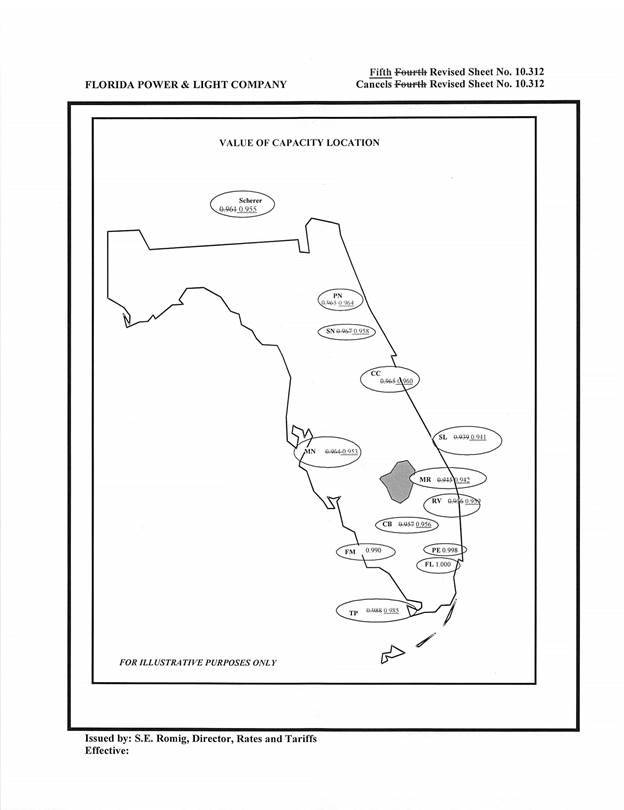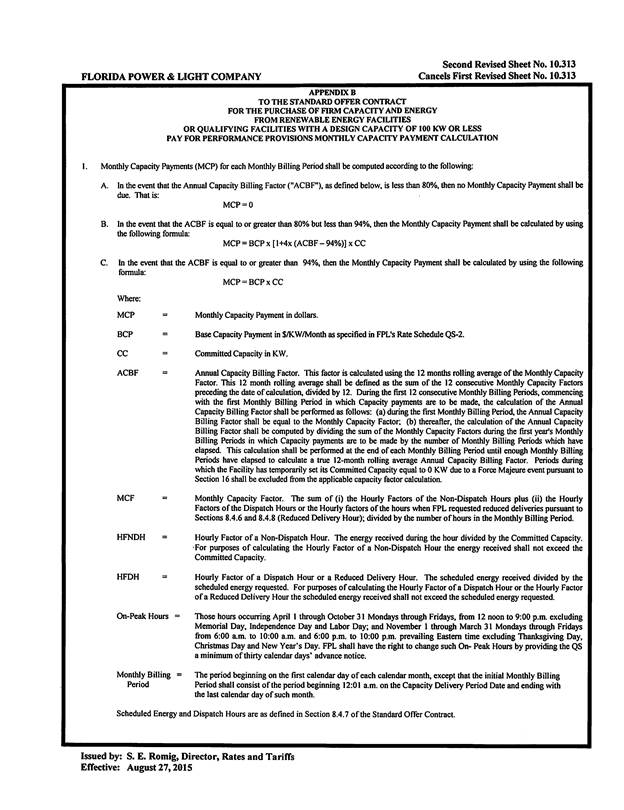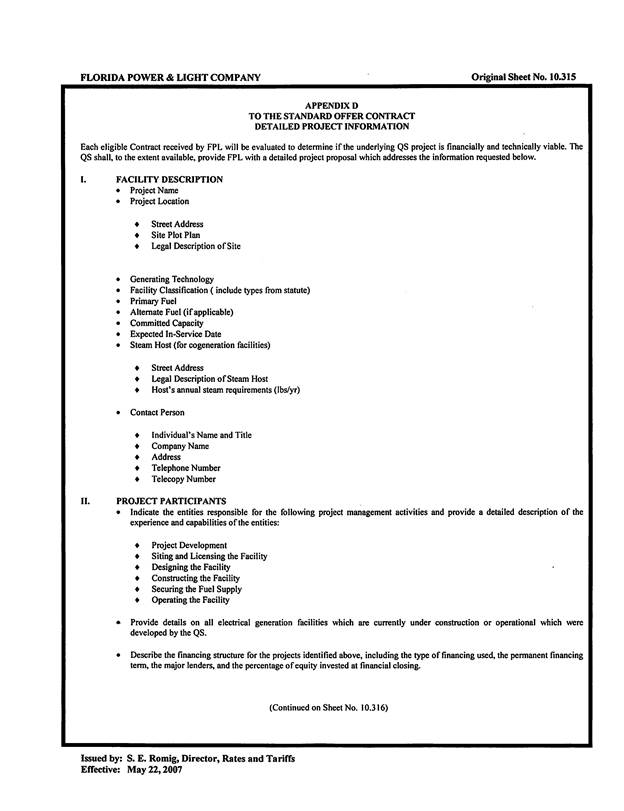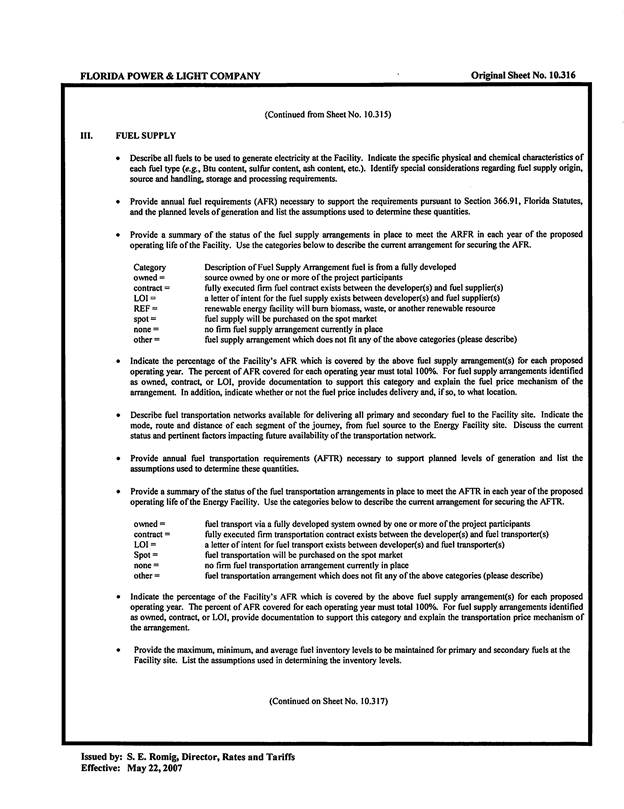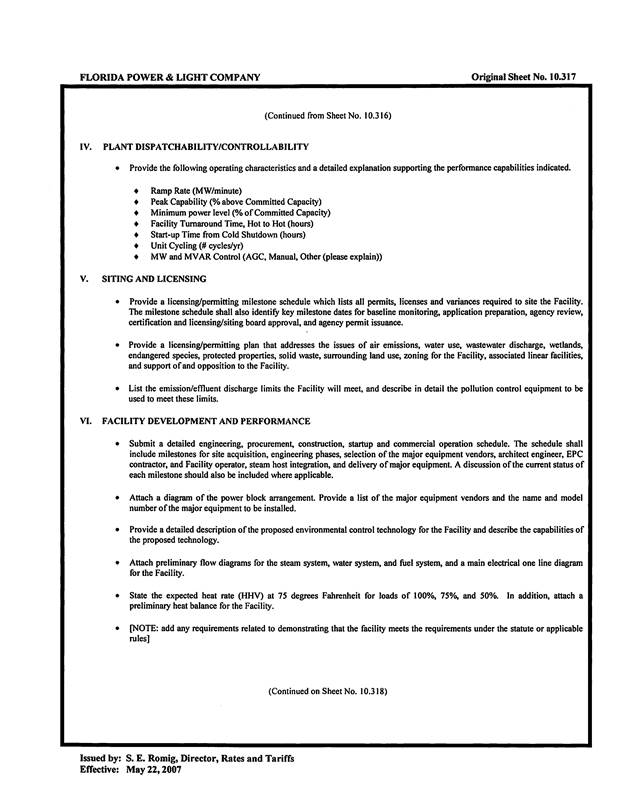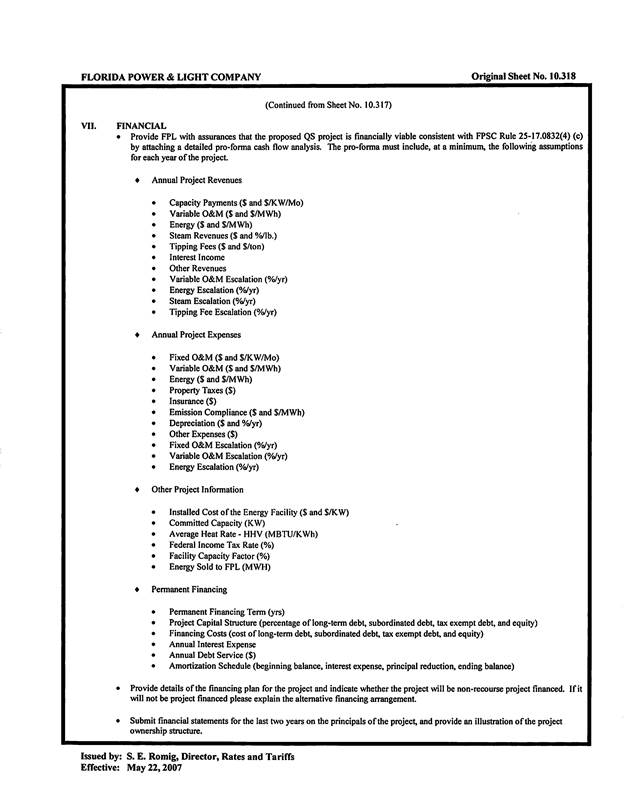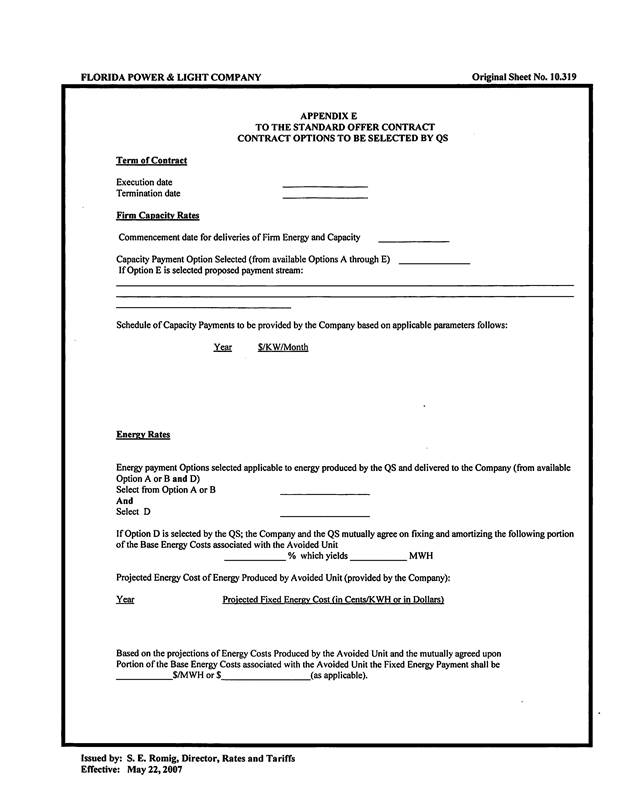Discussion
of Issues
Issue 1:
Should the Commission approve the revised renewable
energy tariff and standard offer contract filed by Florida Power & Light
Company?
Recommendation:
Yes. The provisions of FPLís revised renewable
energy tariff and standard offer contract conform to all requirements of Rules
25-17.200 through 25-17.310, F.A.C. FPLís revised standard offer contract
provides flexibility in the arrangements for payments so that a developer of
renewable generation may select the payment stream best suited to its financial
needs. (Lee)
Staff Analysis:
Rule 25-17.250, F.A.C., requires that FPL, an IOU,
continuously makes available a standard offer contract for the purchase of firm
capacity and energy from renewable generating facilities (RF) and small
qualifying facilities (QF) with design capacities of 100 kilowatts (kW) or
less. Pursuant to Rules 25-17.250(1) and (3), F.A.C., the standard offer
contract must provide a term of at least 10 years, and the payment terms must
be based on the utilityís next avoidable fossil-fueled generating unit
identified in its most recent Ten-Year Site Plan or, if no avoided unit is
identified, its next avoidable planned purchase.
FPL has identified a 1,622 megawatt (MW) natural gas-fired
facility of the combined cycle (CC) technology type as the next fossil-fueled
generating unit in its 2016 Ten-Year Site Plan. The projected in-service date
of this unit is June 1, 2024.
The RF/QF operator may elect to make no commitment as to
the quantity or timing of its deliveries to FPL, and to have a committed
capacity of zero (0) MW. Under such a scenario, the energy is delivered on an
as-available basis and the operator receives only an energy payment.
Alternatively, the RF/QF operator may elect to commit to certain minimum
performance requirements based on the identified avoided unit, such as, being
operational and delivering an agreed upon amount of capacity by the in-service
date of the avoided unit, and thereby becomes eligible for capacity payments in
addition to payments received for energy. The standard offer contract may also
serve as a starting point for negotiation of contract terms by providing
payment information to an RF/QF operator, in a situation where one or both
parties desire particular contract terms other than those established in the
standard offer.
In order to promote renewable generation, the Commission
requires the IOU to offer multiple options for capacity payments, including the
options to receive early or levelized payments. If the RF/QF operator elects to
receive capacity payments under the normal or levelized contract options, it
will receive as-available energy payments only until the in-service date of the
avoided unit (in this case June 1, 2024), and thereafter, begin receiving
capacity payments in addition to the energy payments. If either the early or
early levelized option is selected, then the operator will begin receiving
capacity payments earlier than the in-service date of the avoided unit.
However, payments made under the early capacity payment options tend to be
lower in the later years of the contract term because the net present value
(NPV) of the total payments must remain equal for all contract payment options.
Table 1
below, contains FPLís estimates of the annual payments for each payment option
available under the revised standard offer contract to an operator with a 50 MW
facility operating at a capacity factor of 94 percent, which is the minimum
capacity factor required under the contract to qualify for full capacity
payments. Normal and levelized capacity payments begin in 2024, reflecting the
projected in-service date of the avoided CC unit (June 1, 2024).
Table 1 Ė Estimated Annual Payments to
a 50 MW Renewable Facility
(94% Capacity Factor)
|
Year
|
Energy Payment
|
Capacity Payment (By Type)
|
|
Normal
|
Levelized
|
Early
|
Early Levelized
|
|
$(000)
|
$(000)
|
$(000)
|
$(000)
|
$(000)
|
|
2017
|
9,110
|
-
|
-
|
-
|
-
|
|
2018
|
11,560
|
-
|
-
|
-
|
-
|
|
2019
|
11,658
|
-
|
-
|
-
|
-
|
|
2020
|
11,149
|
-
|
-
|
3,303
|
3,759
|
|
2021
|
12,988
|
-
|
-
|
3,370
|
3,759
|
|
2022
|
12,441
|
-
|
-
|
3,437
|
3,759
|
|
2023
|
13,460
|
-
|
-
|
3,506
|
3,759
|
|
2024
|
15,540
|
5,230
|
5,830
|
3,576
|
3,759
|
|
2025
|
13,979
|
5,341
|
5,830
|
3,647
|
3,759
|
|
2026
|
15,069
|
5,455
|
5,830
|
3,720
|
3,759
|
|
2027
|
16,326
|
5,572
|
5,830
|
3,795
|
3,759
|
|
2028
|
15,421
|
5,691
|
5,830
|
3,870
|
3,759
|
|
2029
|
15,646
|
5,812
|
5,830
|
3,948
|
3,759
|
|
2030
|
16,055
|
5,936
|
5,830
|
4,027
|
3,759
|
|
2031
|
17,330
|
6,063
|
5,830
|
4,107
|
3,759
|
|
2032
|
17,813
|
6,193
|
5,830
|
4,190
|
3,759
|
|
2033
|
17,626
|
6,325
|
5,830
|
4,273
|
3,759
|
|
2034
|
17,632
|
6,460
|
5,830
|
4,359
|
3,759
|
|
2035
|
18,702
|
6,598
|
5,830
|
4,446
|
3,759
|
|
2036
|
19,077
|
6,739
|
5,830
|
4,535
|
3,759
|
|
Total
|
298,581
|
77,417
|
75,791
|
66,109
|
63,908
|
|
NPV (2017$)
|
141,046
|
28,521
|
28,521
|
28,521
|
28,521
|
FPLís revised renewable energy tariff and standard offer
contract, in type-and-strike format, are included as Attachment A to this
recommendation. In addition to the revisions to reflect the 2024 CC unit based
on FPLís current generation plan, the revised standard offer contract also includes updated provisions
regarding the completion/performance security, enhanced notification
requirements, and energy price projections. Staff conducted four data requests
to address those changes. FPLís response to the last data request was dated
August 12, 2016.
In response to staffís data request, FPL described and explained
the specific changes that affect the payment amount. FPL projects that the
costs associated with power plants will marginally increase in the coming years
with the escalation rate for plant costs increasing from 2 percent to 3 percent,
as shown in the proposed tariff page 10.311.1. This escalation rate is a factor
determining the capacity payments by FPL, so an increase in the escalation rate
under the revised standard offer contract results in an increase in capacity
payments to the RF/QF operator.
FPLís proposed tariff increases the required initial completion/performance
security from $30/kW to $50/kW. This security will then increase to $100/kW two
years before the guaranteed capacity delivery date. The current level has not
been adjusted since 1999. FPL evaluated the cost to obtain alternative power
arrangements in the event of a performance failure using the same methodology
for the avoided cost provided in Rule 25-17.0832(6), F.A.C. Based on that, FPL
then assessed the appropriate level of completion/performance security to be
the proposed amount, so that there is reasonable assurance that the RF/QF operator
will satisfy its pre-commercial operation date obligations and compensate FPL
and its customers adequately in the event of a performance failure by the
operator. Further, the cost for obtaining the letter of credit for the completion/performance
security is a fraction of the security amount, therefore this requirement would
not cause undue financial burden to sellers.
For similar reasons, the revised standard offer contract contains
changes intended to reduce and manage the ratepayerís exposure to risks.
Changes were made in notification provisions to shorten the timeframe or to enhance
the requirements for the RF/QF operator. For example, in the proposed tariff
page 9.037, paragraph 9.3, the timeframe to provide a replacement letter of credit
is reduced from 30 days to 10 days.
The revised tariff sheets provide the required capacity
payment pricing information, but the as-available energy cost projections and
fuel cost projections on tariff pages 10.304 and 10.311 have been removed. FPL has
elected to eliminate these as-available energy cost projections, because the
tariffs are typically revised only once a year while forecasted energy prices are
volatile throughout the year. FPL noted that the fuel costs used in calculating
avoided costs for the 2016 standard offer contract have dropped more than 25
percent from those used for the 2015 standard offer contract. Removing these
projections only clarifies that as-available energy cost pricing information
will be provided upon request to reflect the most current market pricing. Staff
notes FPL files actual as-available energy cost †monthly with the Commission pursuant to Rule 25-17.0825(4),
F.A.C.
Conclusion
The provisions
of FPLís revised renewable energy tariff and standard offer contract conform to
all requirements of Rules 25-17.200 through 25-17.310, F.A.C. FPLís revised
standard offer contract provides flexibility in the arrangements for payments
so that a developer of renewable generation my select the payment stream best
suited to its financial needs.
Issue 2:
Should this docket be closed?
Recommendation:
Yes. This docket should be closed upon
issuance of a consummating order, unless a person whose substantial interests
are affected by the Commissionís decision files a protest within 21 days of the
issuance of the Commissionís Proposed Agency Action Order. Potential
signatories should be aware that, if a timely protest is filed, FPLís standard
offer contract may subsequently be revised. (Lherisson)
Staff Analysis:
This docket should be closed upon the issuance of a
consummating order, unless a person whose substantial interests are affected by
the Commissionís decision files a protest within 21 days of the issuance of the
Commissionís Proposed Agency Action Order. Potential signatories should be
aware that, if a timely protest is filed, FPLís standard offer contract may
subsequently be revised.




































